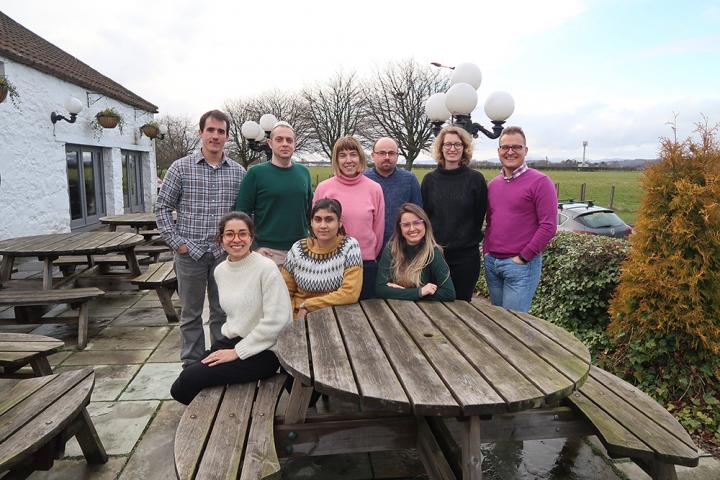Dr Gregor Gorjanc on breeding, even insects
Applying maths in breeding and using insects as a source of protein.

Dr Gregor Gorjanc is an expert in genetics and breeding. He has been working at the Roslin Institute for six years. In this interview he tells MSc Science Communication student Anna Purdue about combining maths and genetics to improve animal and insect breeding.

Can you tell me about your work in a nutshell?
My research group, the HighlanderLab, works on managing and improving populations, mostly of livestock, using different methods involving data science, genetics and breeding. We look at how populations evolve, and what we could do to make them evolve in ways we would like.
Specifically, we are interested in designing breeding programmes that support improving productivity in a sustainable way. This work encompasses a range of traits related to production, reproduction, longevity, disease resistance, quality of products, welfare, environmental impact and others.
We do not focus on a particular trait or groups of traits, but on the overarching breeding environment and methods that enable improvement. This work also involves managing populations, which is very closely related to the work of colleagues in the area of conservation genetics.
Although we are mainly focused on livestock, our work is also relevant to plants and other related areas. For example, I am just about to host a tree geneticist from New Zealand here at the Institute.
Recently we started work on insect breeding, which is really interesting.
We often work with industrial partners or, if we can’t get a partner this way, we will do our own research.
Tell me more about your work with insects.
We started researching insect breeding last year. The Roslin Innovation Centre on our campus hosts a start-up company called Beta Bugs Ltd and they approached us for collaboration on designing an efficient insect breeding programme to improve sustainable production of protein for livestock and aquaculture.
I realised that this project has a huge potential. Not much was being done at that time in terms of research, and there are lots of different insects that we could potentially farm and improve through breeding.
With Beta Bugs we are working on black soldier flies. The larvae of this species eat just about anything and are very efficient at converting organic matter, including food waste and by-products from the food industry, into protein. In addition, this species is easy to handle in large facilities.
Producers harvest the larvae when they are close to the end of this phase of their growth, before turning into a pupa and eventually into a fly. The larvae can be fed, processed or unprocessed, to fish, pigs, chickens and other animals.
The main idea is that, in the UK, we could be self-sufficient in sustainable protein. There is however quite a bit of work ahead for this industry in terms of legislation, production, and use.
We are contributing to these goals with breeding research and development. The black soldier fly has some excellent properties for breeding such as large progeny numbers and it breeds very quickly. The downside is obviously the small size of each individual fly. We are working on designing breeding programmes that exploit the excellent properties and manage the downsides.
Why did you decide to become a scientist, and what drew you to this field in particular?
It happened quite naturally, to be honest. As a child I was quite inquisitive and often bored. I really liked when we formalised something in school, be it in maths or biology. I really liked maths, when I understood it. I also liked biology, when there was a clear framework to it. At the same time I found both very dry because I couldn’t see their application.
I grew up in a city, but my dad came from a farming background. In high school I started to help out on the farm and became more interested in the work that went on there. There was even a time when I wanted to be a farmer.
When I studied animal science, I discovered the field of biostatistics and later its unison with principles of genetics in quantitative genetics and breeding. For the first time, I could see how maths and biology could be combined and applied to something so useful. This area immediately occupied my full attention and since then I have discovered so many interesting uses in livestock, pets, crops, trees, fish and recently insects.
Why did you decide to work at Roslin and what do you enjoy about working here?
I did all of my studies in Slovenia and was working there as an Assistant Professor, but I was somewhat constrained in terms of the research I could do. My colleague moved here and asked me to join him for a short sabbatical, which eventually ended up in six years of very productive science as well as very active translation into practice.
The Roslin Institute is a very vibrant place; there’s lots happening here. I also really appreciate the legacy that the Institute has, and not just with Dolly the sheep. In terms of quantitative genetics and breeding, Roslin is one of the best places in the world to conduct research.
We just celebrated 100 years of genetics here in Edinburgh. If you want to be involved with quantitative genetics and breeding programmes, Roslin is the place to be!
Related links
Why we all need to catch the insect-eating bug
Professor Andrea Wilson on the genetics of disease and behaviour


